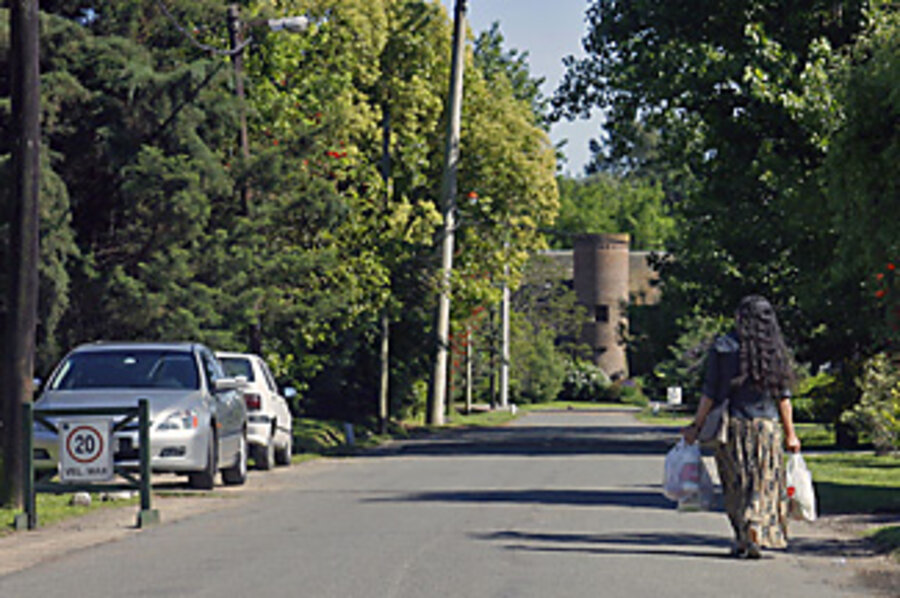Class divide hardens for Argentina's growing poor
Loading...
| Buenos Aires
Florencia Tedin grew up wealthy, but says she never felt any distinction between her prospects and those of her cleaning lady's children.
For years, it was a common Argentine assumption that a taxi driver's son could become a lawyer, the plumber's daughter a psychoanalyst.
But not any more. On a recent day, Ms. Tedin looks at the woman caring for her four small children in their rambling home in a gated community outside Buenos Aires and shakes her head sadly. Today, she says, maids' children will be maids.
The gap between rich and poor has slowly expanded over the decades in a society that has always thought of itself as Latin America's model for egalitarianism.
But the financial crisis that exploded in 2001 – plunging 50 percent of the population into poverty and leading to a spike in crime that pushed city dwellers into gated communities – has caused many to face Argentina's new reality: The family you are born into will largely determine where you end up in life.
"During the crisis, everyone fell," says Osvaldo Giordano, an economist at the Argentinean Institute of Social Development in Buenos Aires. Argentina is recovering, with extended economic growth and poverty rates falling to 25 percent, but the improvements have not spread to all, leaving visible inequality in its wake. "People think we are moving back to the old dream, but we aren't."
Unlike the rest of Latin America, Argentina had vast, productive land and few inhabitants in the 19th century, when Europeans poured into the country, says Maria Laura Alzua, an economist at Mediterranean Foundation, Buenos Aires. A middle class began to rise in the 1920s, and until the '70s, Argentina enjoyed relatively equal income distribution. But a development model based on imports and a history of fiscal mismanagement started to erode the general well-being.
It was really in the '90s, however, when the economy was opened and the public sector privatized, that things began to deteriorate. At the peak of the crisis, the national currency collapsed and savings accounts were wiped out. "Today we are much more like segmented societies in Latin America," says Ms Alzua, who also attributes the income disparities to a decline in the quality of public education.
While unemployment has halved, from around 20 percent at the height of the crisis, half of all jobs are in the informal sector. Few provide benefits, protection, or true prospects for mobility. "The poor are working more to gain the same amount of money," says Agustin Salvia, a sociologist at the Catholic University of Argentina. "In the '90s, there was poverty because of unemployment. It's not the same today."
The income divide is apparent just beyond the gates Ms. Tedin must pass to access her driveway. Her family relocated to this gated community, where 100 families live on 100 plots of land, for security, says Tedin, whose grew up in the same area, but in the center of town.
Known as "countries," they were once the weekend getaways for the urban elite, but now more and more Buenos Aires residents are making them their permanent homes.
Some communities are massive mini-cites with schools, churches, and shopping centers. "It's a little bit like the 'Truman Show,' " says Tedin, whose manicured lawn looks onto an artificial lake.
"If the country becomes secure again, I'd like to live outside," she says.
Only a few blocks away, on the main road, Nieve Barrio lives in a simple concrete home. Many of her neighborhood's streets are unpaved, dirt alleys that become giant puddles when it rains. Most residents are domestic workers, like Ms. Barrio, or bricklayers and gardeners, and many work in the gated communities nearby. Barrio also mends clothes on the side.
Barrio says she raised six children as a single mother on a maid's salary, but that is no longer possible today.
When she first moved here, she says it was open country, dotted by a few rustic homes. Now, the gated population provides employment but also reminds them daily of inequality. "Things are so much harder today," she says.
Argentina's poverty rates are lower than most others in the region – about a quarter of the population – but still high for a country that once had a 5 percent poverty rate in the 1970s.
"There is no other county with such social regression, such social shame," says Bernardo Kosacoff, the representative of the United Nations Economic Commission for Latin America and the Caribbean in Argentina.
Mr. Kosacoff says the country has experienced 14 financial crises in the past 30 years, exhibiting more volatility and stunted growth than any other country in the region besides Nicaragua.
Jorge Giacobbe, an independent political consultant in Buenos Aires, agrees, "Argentina is going backwards, not forwards."





